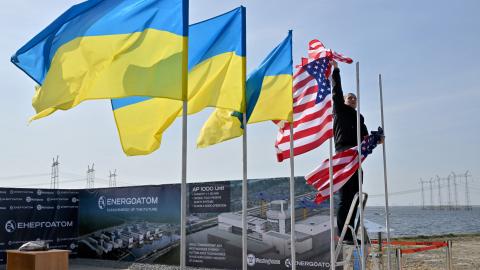As Americans head to the polls next month to elect their next president, traditional bread-and-butter issues dominate the political debate. Concerns about rising grocery bills, access to affordable healthcare, debates over what is being taught in public schools and responses to illegal immigration are at the forefront of voters’ minds. Unless the US is directly involved in a war, foreign policy typically takes a back seat in election campaigns, and Ukraine is no exception.
While former President Donald Trump and Vice President Kamala Harris have occasionally been asked about Ukraine in interviews, the conflict has not featured prominently on the campaign trail, despite its high geopolitical stakes. During the Trump-Harris presidential debate, there was one question on Ukraine, but the issue was completely absent from the recent vice-presidential debate. However, by piecing together their past public statements, we can form a reasonable picture of how each candidate might approach the Ukraine-Russia war — and, for Ukraine, neither scenario looks particularly hopeful.
Trump has been the most vocal critic of continued US aid to Ukraine. He has mocked President Volodymyr Zelensky for seeking American support, suggested that Moscow has a legitimate claim to some of Ukraine’s territory and repeatedly claimed he could end the war within 24 hours of taking office. For a country fighting for its survival, Trump’s statements do not inspire confidence. His running mate, Sen. J.D. Vance, has gone even further, suggesting that Ukraine might have to cede territory to Russia and make a formal pledge to remain outside of NATO in the future as part of any peace plan.
Although Trump frequently claims he can quickly end the war, he has yet to offer even a basic outline of how he would achieve this. The worst-case scenario for Ukraine under a Trump administration would be the withdrawal of US support, potentially forcing Ukraine to cede parts of its territory to Russia as part of a ceasefire agreement. Given Russia’s track record — such as its failure to honor the peace deal that ended the 2008 Russo-Georgian war or the Minsk agreements following its 2014 invasion of Ukraine — there is little reason to believe Moscow would honor any new ceasefire. While Trump’s approach might bring a short-term halt to hostilities, history suggests that Russia would use the time to rebuild its military and resume its assault on Ukraine later.
A Harris administration, while less overtly hostile to Ukraine, may not be much better for different reasons. It is likely that Harris would continue the Biden administration’s strategy of doing just enough to support Ukraine while avoiding decisive action. Since the war began, nearly every major decision to provide Ukraine with critical weapons and munitions has been met with hesitation. While the Biden administration deserves credit for accurately predicting Russia’s invasion, its response has been marked by delays.
Key military aid, including air defense systems, tanks, fighter jets and long-range missiles, has been slow to arrive and often too late to make a meaningful impact on the battlefield. So far, Harris has not given any indication that she will change from the approach taken by President Joe Biden. Without arming Ukraine to win, the war is needlessly dragged out longer.
Neither Trump nor Harris seems to fully grasp the historical significance of this moment. Russia’s invasion of Ukraine and annexation of parts of its territory represents the first time since Saddam Hussein’s invasion of Kuwait in 1990 that armed forces have been used to seize part of a neighboring country. The outcome of this war will have lasting implications for the stability and security of Europe throughout the 21st century.
Europe’s importance to the US cannot be overstated. It is America’s biggest export market and the single largest source of foreign direct investment, leading to the creation of millions of American jobs. US policymakers have a lot at stake in ensuring Europe remains stable and secure. However, neither Trump nor Harris has shown on the campaign trail that they understand how vital Ukraine’s success is to Europe and, by extension, the US’ own economic and strategic interests.
So, what can be done to mitigate the worst outcomes under either a Trump or a Harris administration? For Ukraine, it is crucial to continue making the case to the American public about why supporting its defense is in the US’ interest. At the same time, Ukraine must ramp up its own domestic military production to reduce its reliance on foreign partners such as the US.
Europe will also need to do more. Right now, there is an equitable balance between what Europe is collectively providing to Ukraine and what the US is doing. If the stakes are high for the US, they are even higher for Europe. Should American leadership falter under either potential administration, Europe will have no choice but to step up, regardless of how reluctant it may be to do so.
Finally, the US Congress will play a pivotal role in ensuring continued American support for Ukraine after the election. Congress holds the power of the purse, which gives it significant influence over foreign policy. Despite vocal critics from both the far left and far right, there is still strong bipartisan support in Congress for providing military aid to Ukraine. Congress must work with the next occupant of the Oval Office to ensure that US policy toward Ukraine remains sound and consistent.
As the world watches the outcome of the American election, perhaps no other country is doing so more than Ukraine. Regardless of who wins the White House, the reality on the ground for Kyiv remains unchanged. Hundreds of thousands of Ukrainians continue to fight for their country’s survival, culture, language and borders.
For Ukraine, this is a war of national survival and the next US president will be just one of many factors in its continued struggle. Sadly, things are not looking good.
Enjoyed this article? Subscribe to Hudson’s newsletters to stay up to date with our latest content.



















